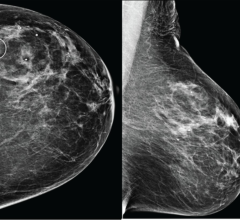
March 12, 2014 — Computed tomography (CT) scans routinely taken to guide the treatment of pancreatic cancer may provide an important secondary benefit. According to research from The University of Texas MD Anderson Cancer Center, the scans also reflect how well chemotherapy will penetrate the tumor, predicting the effectiveness of treatment.
The research, published in the Journal of Clinical Investigation, is the first human study to address the issue of chemotherapy delivery to pancreatic tumors, a problem previously shown in animal studies.
"We found that the distribution of intravenous dye used in CT scans is a surrogate for chemotherapy delivery in the tumor," said Jason Fleming, M.D., professor in Surgical Oncology and corresponding author of the study. "Our results indicate that combining data from routine CT scans and using a mathematical formula developed by our team can predict response, guide patient treatment and lead to efforts to improve drug delivery."
Pancreatic tumors contain disorganized or nonfunctional blood vessels, high proportions of fibrotic tissue and molecular variations that create barriers for a drug to reach its target. It's a disease with a poor prognosis and the American Cancer Society estimates more than 39,000 people will die in 2014 as a result.
"Chemotherapy is used every day, however we've done very little to demonstrate that the drug actually reaches the tumor efficiently," Fleming said. "Results from our previous clinical trials at MD Anderson taught us that when chemotherapy kills most of a patient's tumor, the patient has a better chance of being a long-term survivor."
Researchers first enrolled 12 patients with primary pancreatic disease who would undergo a surgical resection. During surgery, each patient received an infusion of the chemotherapy drug gemcitabine. After surgery, the tumor DNA was analyzed for penetration of gemcitabine.
Gemcitabine is delivered to tumor DNA primarily through a protein called the human equilibrative nucleoside transporter (hENT1). Previous studies have shown its expression varies in pancreatic tumors, linking the protein to drug response.
For patients in the study with dense, fibrotic tumors and not much hENT1 protein, the chemotherapy was delivered constantly but its uptake was minimal since the drug was not reaching cancer cells, Fleming said.
Researchers found gemcitabine penetrated tumors at varying levels in the group of 12 patients and those with greater gemcitabine levels responded better to therapy and had improved outcomes. After seeing this difference, the team examined past CT scans from another group of patients to compare how the drug reached tumor cells.
The research team analyzed scans from 176 patients (12 who received gemcitabine infusion during surgery, 110 who received presurgical gemcitabine-based chemoradiation and 55 who received upfront surgery to remove the tumor).
After reviewing the data, researchers noticed visual differences in tumors as a result of the CT contrast being absorbed differently. Based on these observations, Fleming and his colleagues began to question whether the intravenous contrast used for CT scans predicted the path and absorption of gemcitabine. It turned out this theory was true.
By employing models to measure factors that influence drug delivery, researchers found resected tumors showed up to six-fold differences in gemcitabine incorporation.
"This work is showing that solid tumors are much more heterogeneous than we thought with respect to drug delivery," Fleming said. "Going forward the implication is that molecular information from a biopsy of the tumor can be combined with data from a standard CT scan to place patients into categories that predict their response to therapy."
Additionally, Fleming said the trial implications are broad and could apply to other solid tumors. Researchers are beginning to look at existing drugs, such as losartan, as it could change the makeup of dense tumors, allowing better delivery of chemotherapy for patients who otherwise would have a poor response.
"The nice thing is that we can measure the effect of these new and repurposed drugs by using intravenous contrast in CT scans as a surrogate, so we don't have to commit a patient to receive a cancer drug until we know it improves the tumor characteristics," he added.
Future research is required to standardize this method of matching patients' tumors to the most promising drugs.
For more information: www.jci.org


 December 10, 2025
December 10, 2025 









